Study on Dynamic Impact Response and Optimal Constitutive Model of Al-Mg-Si Aluminum Alloy
Abstract
1. Introduction
2. Methods
3. Results
3.1. Flow Stress–Strain Relationship and Thermal–Mechanical Behavior under Impact Condition
3.2. Dynamic Impact Constitutive Model
3.3. Micro-Morphology Analysis of Materials in Impact State
4. Conclusions
- Through analysis of the real stress–strain curve, it is founded that when the ambient temperature is 298.15~473.15 K and the strain rate is high, the dynamic mechanical response behavior of 6082 aluminum alloy shows that the internal thermal softening effect of the material is dominant in the competition with work hardening (strain hardening), resulting in a decrease in the flow stress of 6082 aluminum alloy, and the elastic modulus is negatively correlated with the strain rate and temperature. Yield strength is negatively correlated with temperature and positively correlated with strain rate.
- Based on the Johnson–Cook rheological stress–strain constitutive model, the strain- rate strengthening term and temperature softening term in the model are appropriately improved by introducing absolute heating, and the improved constitutive model is obtained as follows: . By comparing the constitutive model with the experimental curve, it is found that the optimized model can fit well with the experimental curve, and it can also reflect the competitive dynamics of strain hardening and high temperature softening of materials at high strain rate. This verifies the accuracy of the model and provides a theoretical basis for the engineering application of materials.
Author Contributions
Funding
Data Availability Statement
Acknowledgments
Conflicts of Interest
References
- Jandaghi, M.R.; Pouraliakbar, H. Study on the effect of post-annealing on the microstructural evolutions and mechanical properties of rolled CGPed aluminum-manganese-silicon alloy. J. Mater. Sci. Eng. A 2017, 679, 493. [Google Scholar] [CrossRef]
- Panagopoulos, C.N.; Georgiou, E.P.; Gavras, A.G. Corrosion and wear of 6082 aluminum alloy. Tribol. Int. 2009, 42, 886–889. [Google Scholar] [CrossRef]
- Briottet, L.; Jonas, J.J.; Montheillet, F. A mechanical interpretation of the activation energy of high temperature deformation in two phase materials. Acta Mater. 1996, 44, 1665–1672. [Google Scholar] [CrossRef]
- Liu, W.; Qiu, Q.; Zhou, F.; Chen, Y.; Huang, H. Effect of aging treatment on dynamic mechanical properties and microstructure evolution of 7N01 aluminum alloy at high temperature. J. Rare Met. Mater. Eng. 2018, 47, 6. [Google Scholar]
- Sathish, T.; Karthick, S. Wear behaviour analysis on aluminium alloy 7050 with reinforced SiC through taguchi approach. J. Mater. Res. Technol. 2020, 9, 3481–3487. [Google Scholar] [CrossRef]
- Viana, F.; Pinto, A.; Santos, H.; Lopes, A.B. Retrogression and re-ageing of 7075 aluminium alloy: Microstructural characterization. J. Mater. Process. Technol. 1999, 92–93, 54–59. [Google Scholar] [CrossRef]
- Vasanthakumar, P.; Sekar, K.; Venkatesh, K. Recent developments in powder metallurgy based aluminium alloy composite for aerospace applications. Mater. Today Proc. 2019, 18, 5400–5409. [Google Scholar] [CrossRef]
- Tan, Q.; Zhang, J.; Sun, Q.; Fan, Z.; Li, G.; Yin, Y.; Liu, Y.; Zhang, M.-X. Inoculation treatment of an additively manufactured 2024 aluminium alloy with titanium nanoparticles. Acta Mater. 2020, 196, 1–16. [Google Scholar] [CrossRef]
- Natesan, E.; Ahlstrm, J.; Eriksson, S.; Persson, C. Effects of Temperature on the Evolution of Yield Surface and Stress Asymmetry in A356–T7 Cast Aluminium Alloy. Materials 2021, 14, 7898. [Google Scholar] [CrossRef]
- Han, L.; Guo, Y.; Lin, P.; Zhang, G. Study on Weldability of Aluminium Alloy TL091 in Resistance Spot Welding with Intermediate Frequency and Direct Current. DEStech Trans. Mater. Sci. Eng. 2021, 42, 105–125. [Google Scholar] [CrossRef]
- Agar, S.; Markoli, B.; Nagli, I.; Šturm, R. The Influence of Age Hardening and Shot Peening on the Surface Properties of 7075 Aluminium Alloy. Materials 2021, 14, 2220. [Google Scholar]
- Kok, M. Production and mechanical properties of Al2O3 particle-reinforced 2024 aluminium alloy composites. J. Mater. Process. Technol. 2005, 161, 381–387. [Google Scholar] [CrossRef]
- Guillaumin, V.; Mankowski, G. Localized corrosion of 6056 T6 aluminium alloy in chloride media. Corrosionence 2000, 42, 105–125. [Google Scholar] [CrossRef]
- Sahin, Y. Preparation and some properties of SiC particle reinforced aluminium alloy composites. Mater. Des. 2003, 24, 671–679. [Google Scholar] [CrossRef]
- Tian, X.; Guo, J. Dynamic mechanical properties and modification of fracture criteria of 6061-T651 aluminum alloy. Eng. Fract. Mech. 2022, 262, 108273. [Google Scholar] [CrossRef]
- Liu, W.; He, Z.; Chen, Y.; Tang, S. Dynamic mechanical properties and constitutive equations of 2519A aluminum alloy. Trans. Nonferr. Met. Soc. China 2014, 24, 2179–2186. [Google Scholar] [CrossRef]
- Feng, Y.; Zhu, Z.G.; Pan, Y.; Hu, S. Dynamic Mechanical Properties of Aluminum Alloy Foams. Rare Met. Mater. Eng. 2005, 34, 544–548. [Google Scholar]
- Deng, Y.; Zhang, Y.; Zeng, X.; Yang, Y. Dynamic mechanical properties and fracture criterion correction of 6061-T651 aluminum alloy. J. Mech. Eng. 2020, 56, 81–91. [Google Scholar]
- Li, S.; Li, L.; He, H.; Liu, Z.; Zhang, L. Effect of Dynamic Recrystallization on Microstructure and Mechanical Properties of Welded Zone of Al-Mg-Si Aluminum Alloy Profile Extruded by Split Die. Rare Met. Mater. Eng. 2019, 29, 1803–1815. [Google Scholar]
- Wei, S.; Haley; Tong, W.; Zhang, H.; Wang, X.; Wang, S.; Wang, L. Study on Dynamic Mechanical Properties of 6005A-T6 Aluminum Alloy for Automobile. Rare Met. Mater. Eng. 2021, 50, 2118–2124. [Google Scholar]
- Guo, Y.; Yang, H.; Liu, X.; He, S.; Wang, J. Study on dynamic mechanical properties of closed-cell aluminum foam at medium and low strain rates. Vib. Impact 2020, 39, 282–288. [Google Scholar]
- Khan, M.A.; Wang, Y.; Yasin, G.; Malik, A.; Nazeer, F.; Qamar Khan, W.; Zhang, H.; Ahmed, T. Microstructure characteristic of spray formed 7055 Al alloy subjected to ballistic impact by two different steel core projectiles impact. J. Mater. Res. Technol. 2019, 8, 6177–6190. [Google Scholar] [CrossRef]
- Hu, J.L.; Wu, X.J.; Bo, H.; Jiao, Z.; Huang, S.; Jin, M. Dislocation density model and microstructure of 7A85 aluminum alloy during thermal deformation. J. Cent. South Univ. 2021, 28, 2999–3007. [Google Scholar] [CrossRef]
- Yang, Y.; Li, D.H.; Zheng, H.G.; Li, X.M.; Jiang, F. Self-organization behaviors of shear bands in 7075 T73 and annealed aluminum alloy. Mater. Sci. Eng. A 2009, 527, 344–354. [Google Scholar] [CrossRef]
- Mondal, C.; Mishra, B.; Jena, P.K.; Siva Kumar, K.; Bhat, T.B. Effect of heat treatment on the behavior of an AA7055 aluminum alloy during ballistic impact. Int. J. Impact Eng. 2011, 38, 745–754. [Google Scholar] [CrossRef]
- Kolsky, H. An Investigation of the Mechanical Properties of Materials at very High Rates of Loading. Proc. Phys. Soc. B 1949, 62, 676. [Google Scholar] [CrossRef]
- Chen, R.; Lu, F.; Lin, Y.; Zhao, P.D.; Li, J.L.; Xia, K.W. Research progress of experimental technology of split Hopkinson compression bar. Mech. Prog. 2009, 39, 576–587. [Google Scholar]
- Zhang, P.; Wang, Y.; Xie, Y.; Zhou, Y. A study on the dynamic shock performance of 7055-T6I4 aluminum alloy based on experimental and simulation. Vacuum 2018, 157, 306–311. [Google Scholar] [CrossRef]
- Ding, S.; Khan, S.A.; Yanagimoto, J. Constitutive descriptions and microstructure evolution of extruded A5083 aluminum alloy during hot compression. Mater. Sci. Eng. A. Struct. Mater. Prop. Misrostruct. Process. 2018, 728, 133–143. [Google Scholar] [CrossRef]
- Zhang, Y.H.; Wang, X.M.; Wei, C.; Zhang, Q.L. Dynamic mechanical properties and instability behavior of layered backfill under intermediate strain rates. Trans. Nonferr. Met. Soc. China 2017, 27, 1608–1617. [Google Scholar] [CrossRef]
- Bai, Q.L.; Li, H.X.; Qiang, D.; Zhang, J.S. Mechanical properties and constitutive behaviors of as-cast 7050 aluminum alloy from room temperature to above the solidus temperature. Int. J. Miner. Metall. Mater. 2016, 23, 949–958. [Google Scholar] [CrossRef]
- Zhang, D.N.; Shangguan, Q.Q.; Xie, C.J. A modified Johnson-Cook model of dynamic tensile behaviors for 7075-T6 aluminum alloy. J. Alloy. Compd. Interdiscip. J. Mater. Sci. Solid-State Chem. Phys. 2015, 619, 186–194. [Google Scholar] [CrossRef]
- Mirzadeh, H. Simple physically-based constitutive equations for hot deformation of 2024 and 7075 aluminum alloys. Trans. Nonferr. Met. Soc. China 2015, 25, 1614–1618. [Google Scholar] [CrossRef]
- Gao, N.; Zhu, Z.W. Experimental Study of Wide Strain Rates and Constitutive Model Based on Damage of 5083 Aluminum Alloy. Chin. J. High Press. Phys. 2017, 31, 51–60. [Google Scholar]
- Noble, J.P.; Harding, J. Temperature measurement in the tensile Hopkinson bar test. Meas. Sci. Technol. 1999, 5, 1163. [Google Scholar] [CrossRef]
- Nemat-Nasser, K.S. Determination of temperature rise during high strain rate deformation. Mech. Mater. 1998, 27, 1–12. [Google Scholar]
- White; Li, Y.; Sun, C.; Wang, Y. Mathematical Analysis of Adiabatic Shear Band: The Physics and Mathematics of Adiabatic shear Bands; Beijing Institute of Technology Press: Beijing, China, 2013. [Google Scholar]
- Adesola, A.O.; Odeshi, A.G.; Lanke, U.D. The effects of aging treatment and strain rates on damage evolution in AA 6061 aluminum alloy in compression. Mater. Des. 2013, 45, 212–221. [Google Scholar] [CrossRef]
- Odeshi, A.G.; Adesola, A.O.; Badmos, A.Y. Failure of AA 6061 and 2099 aluminum alloys under dynamic shock loading. Eng. Fail. Anal. 2013, 35, 302–314. [Google Scholar] [CrossRef]
- Xu, Y.B.; Zhong, W.L.; Chen, Y.J.; Shen, L.T.; Liu, Q.; Bai, Y.L.; Meyers, M.A. Shear localization and recrystallization in dynamic deformation of 8090 Al–Li alloy. Mater. Sci. Eng. A 2001, 299, 287–295. [Google Scholar] [CrossRef]
- Tiamiyu, A.A.; Basu, R.; Odeshi, A.G.; Szpunar, J.A. Plastic deformation in relation to microstructure and texture evolution in AA 2017-T451 and AA 2624-T351 aluminum alloys under dynamic impact loading. Mater. Sci. Eng. A 2015, 636, 379–388. [Google Scholar] [CrossRef]
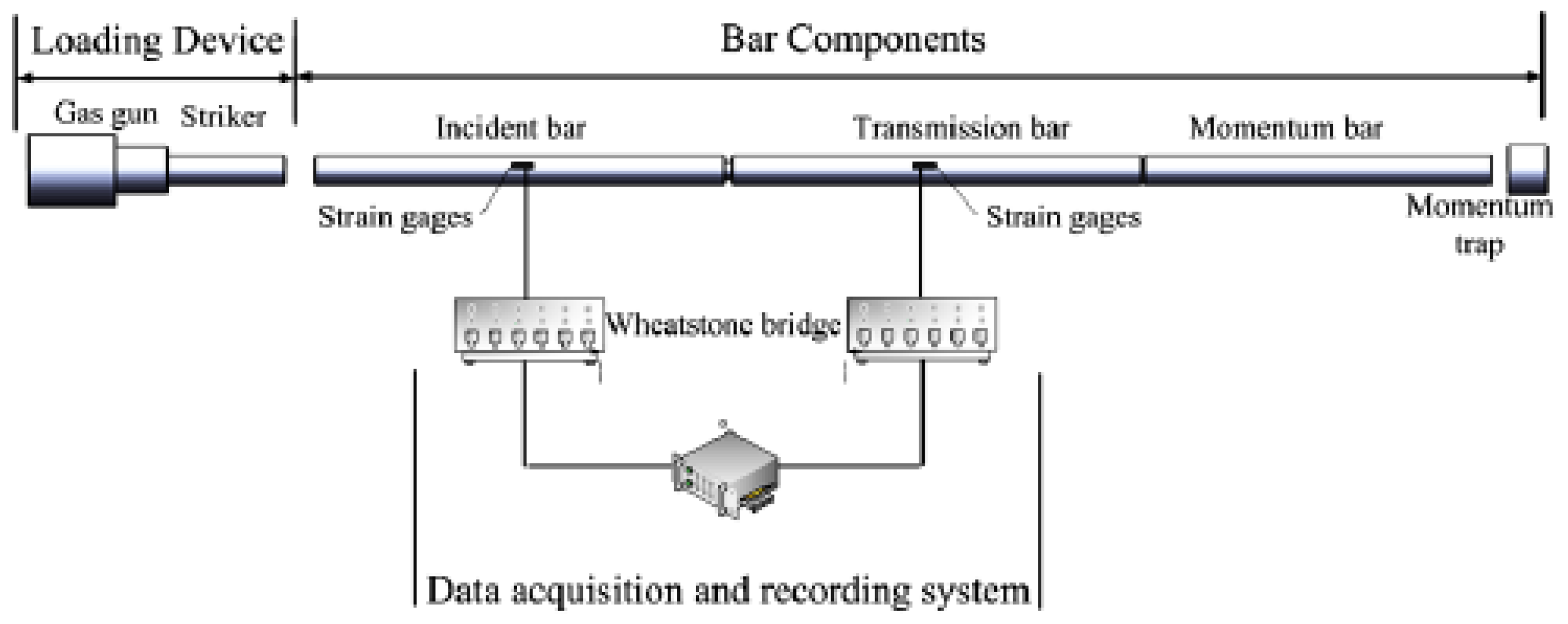
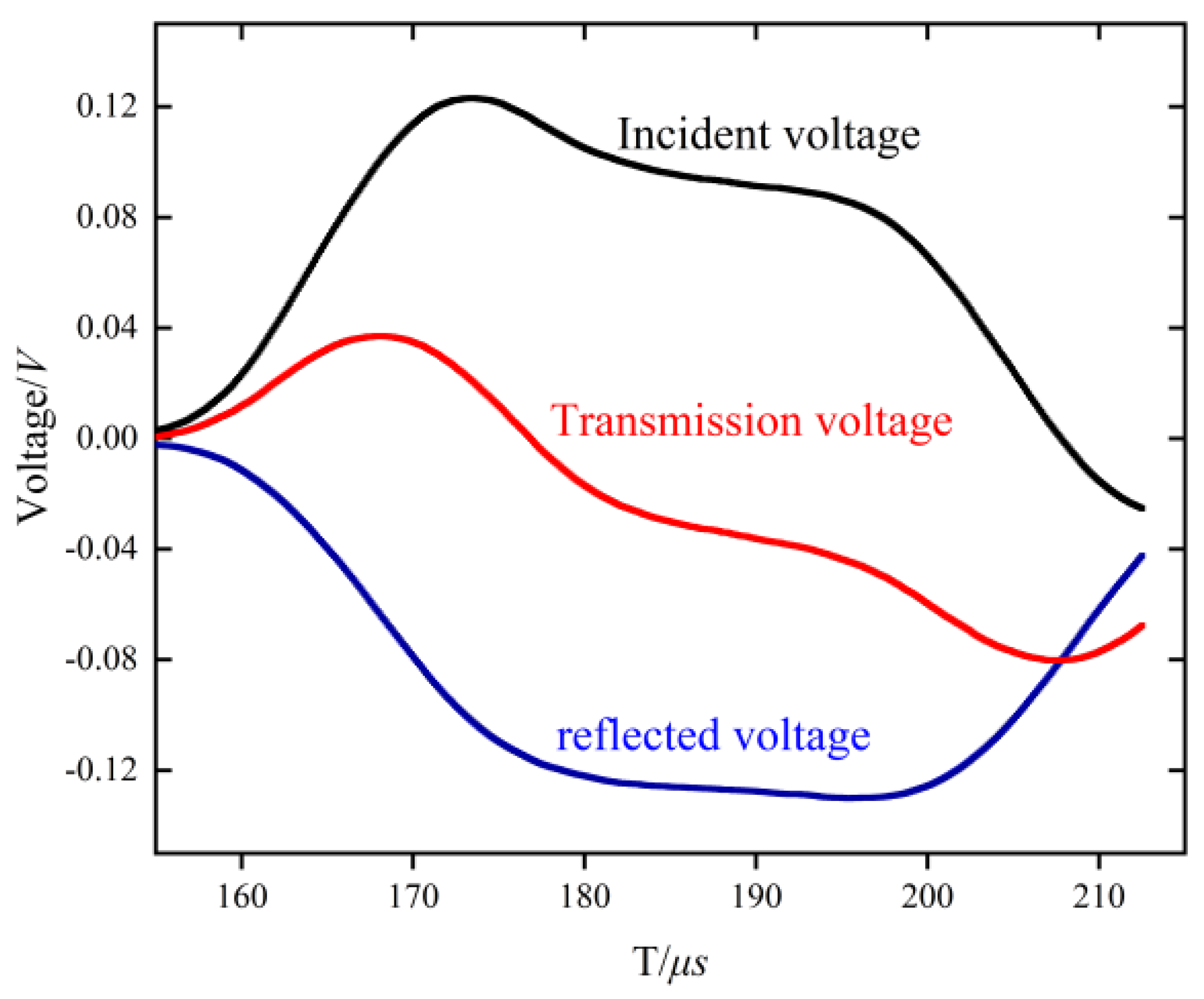



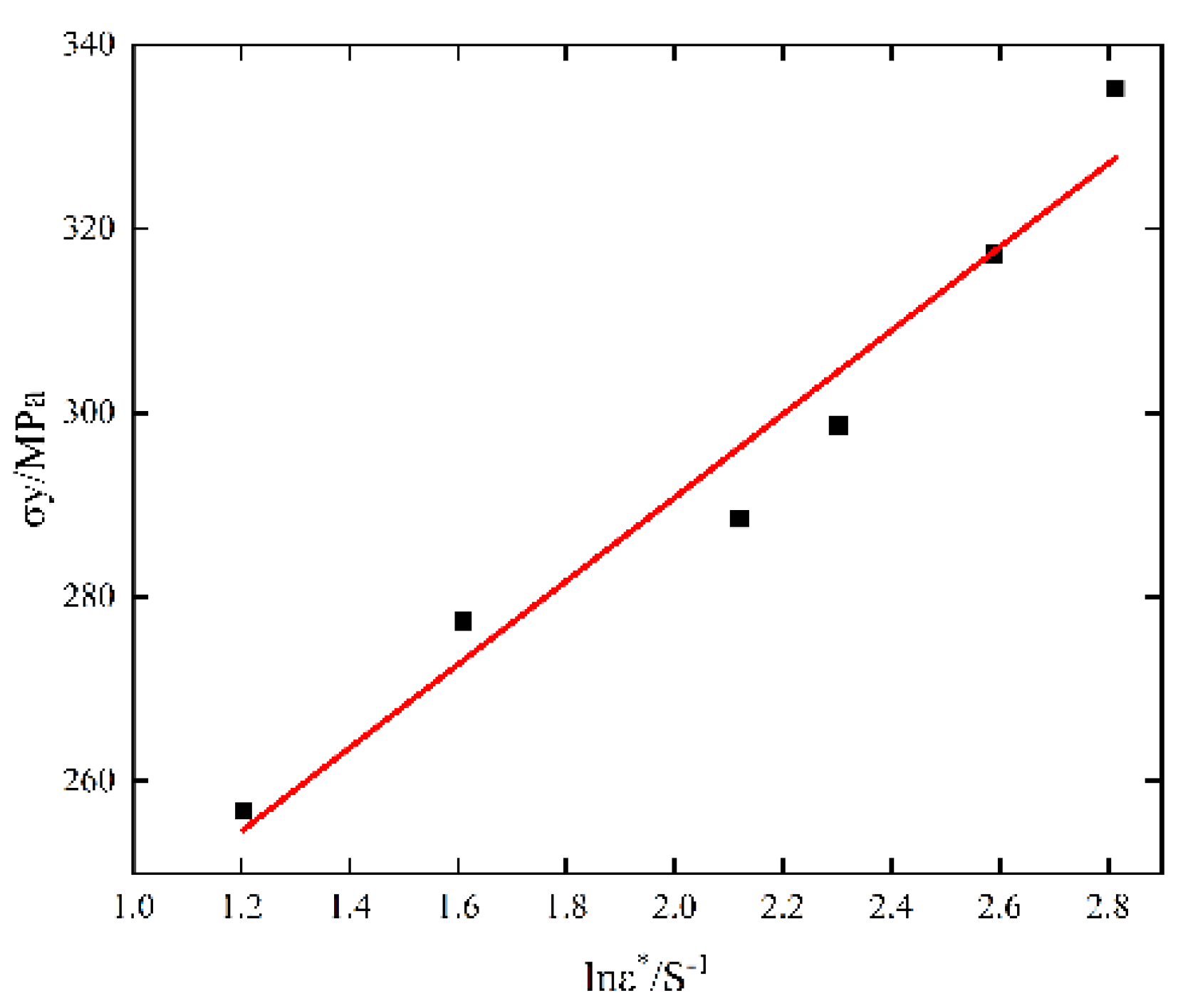
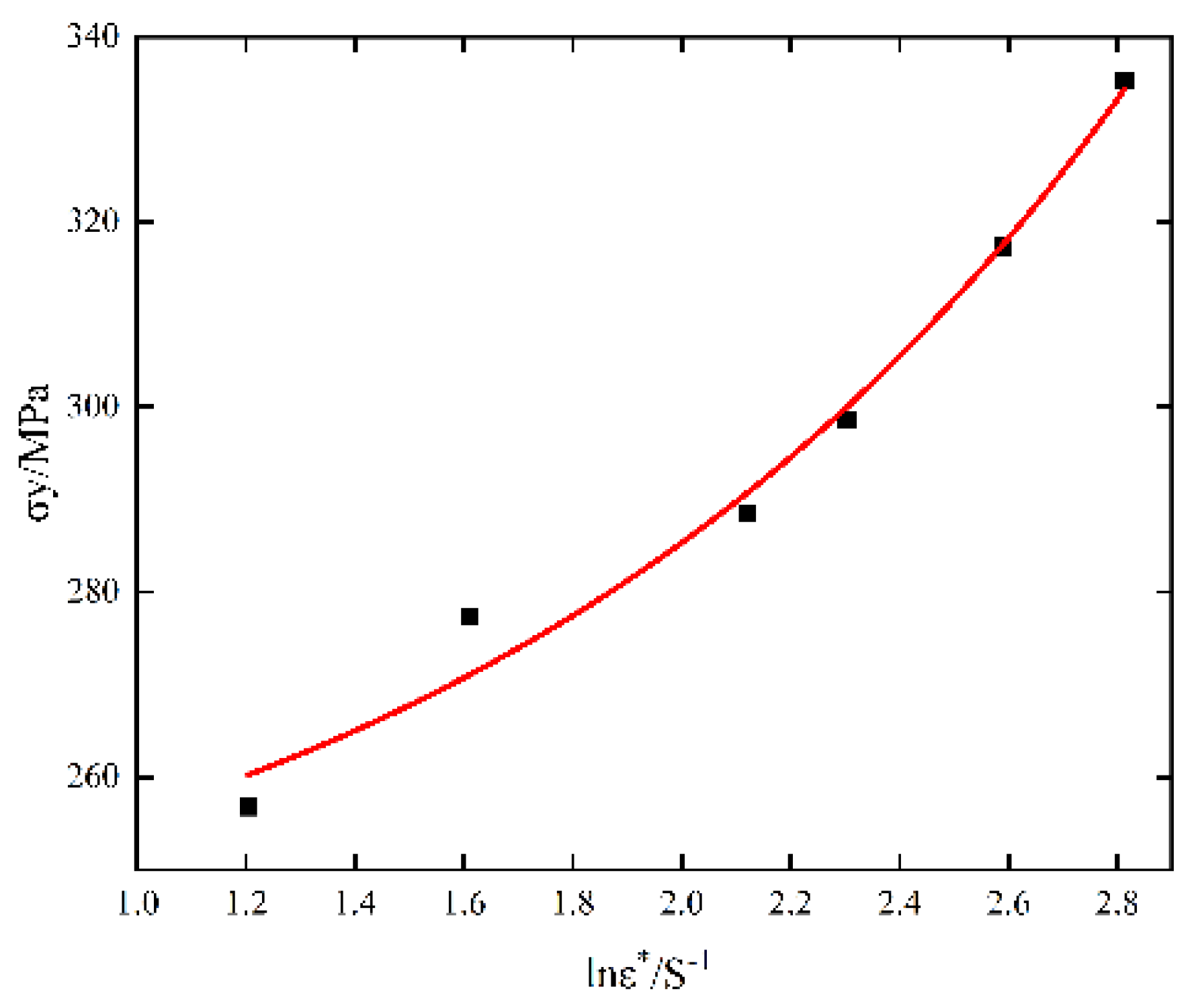
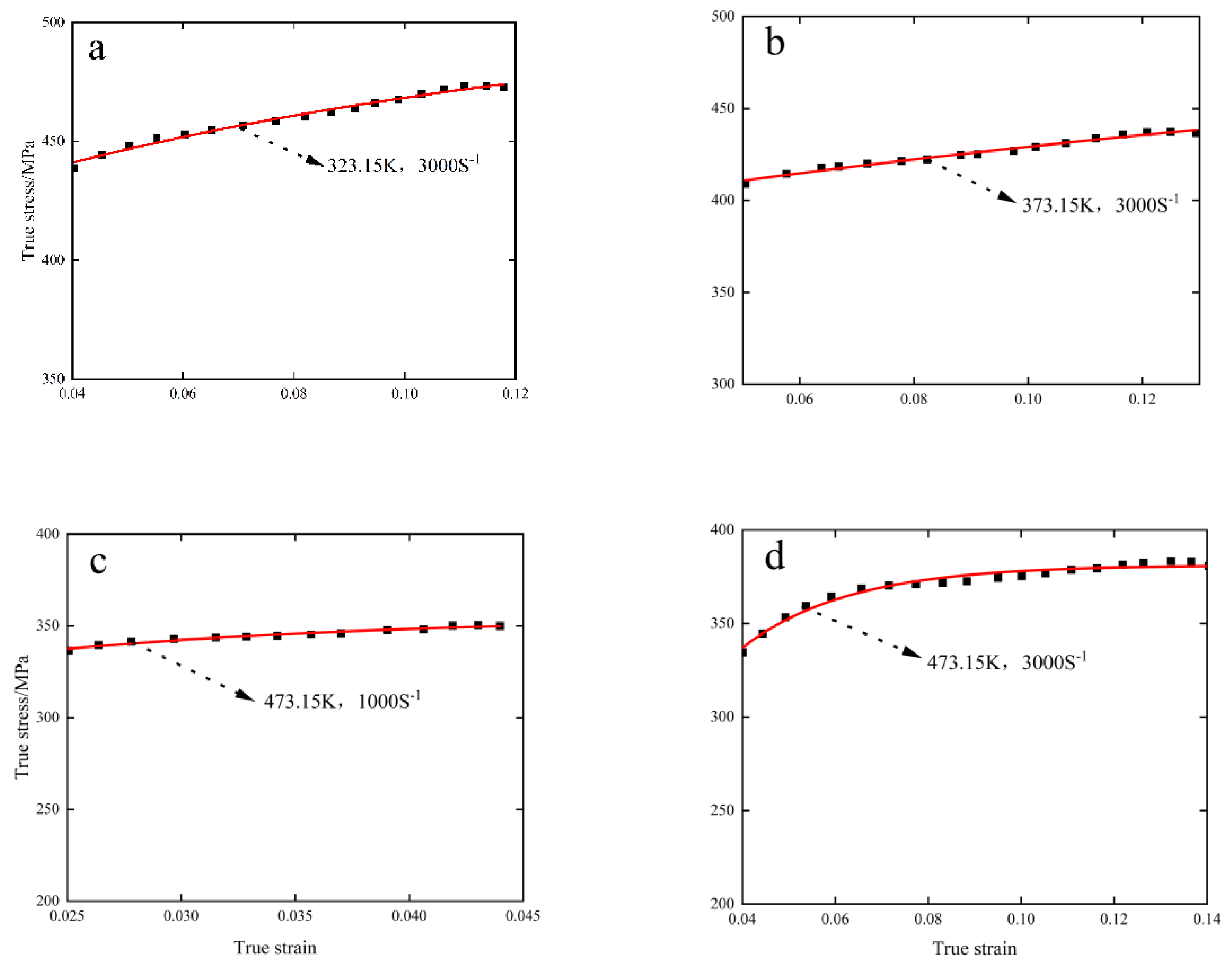
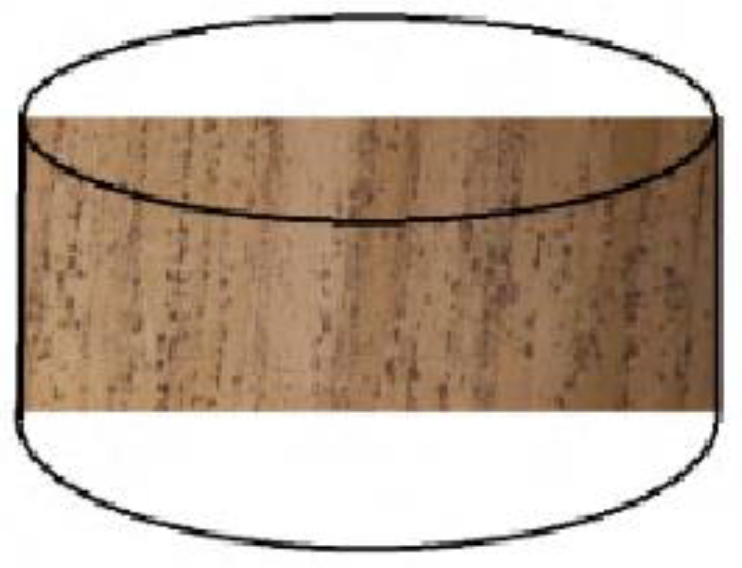

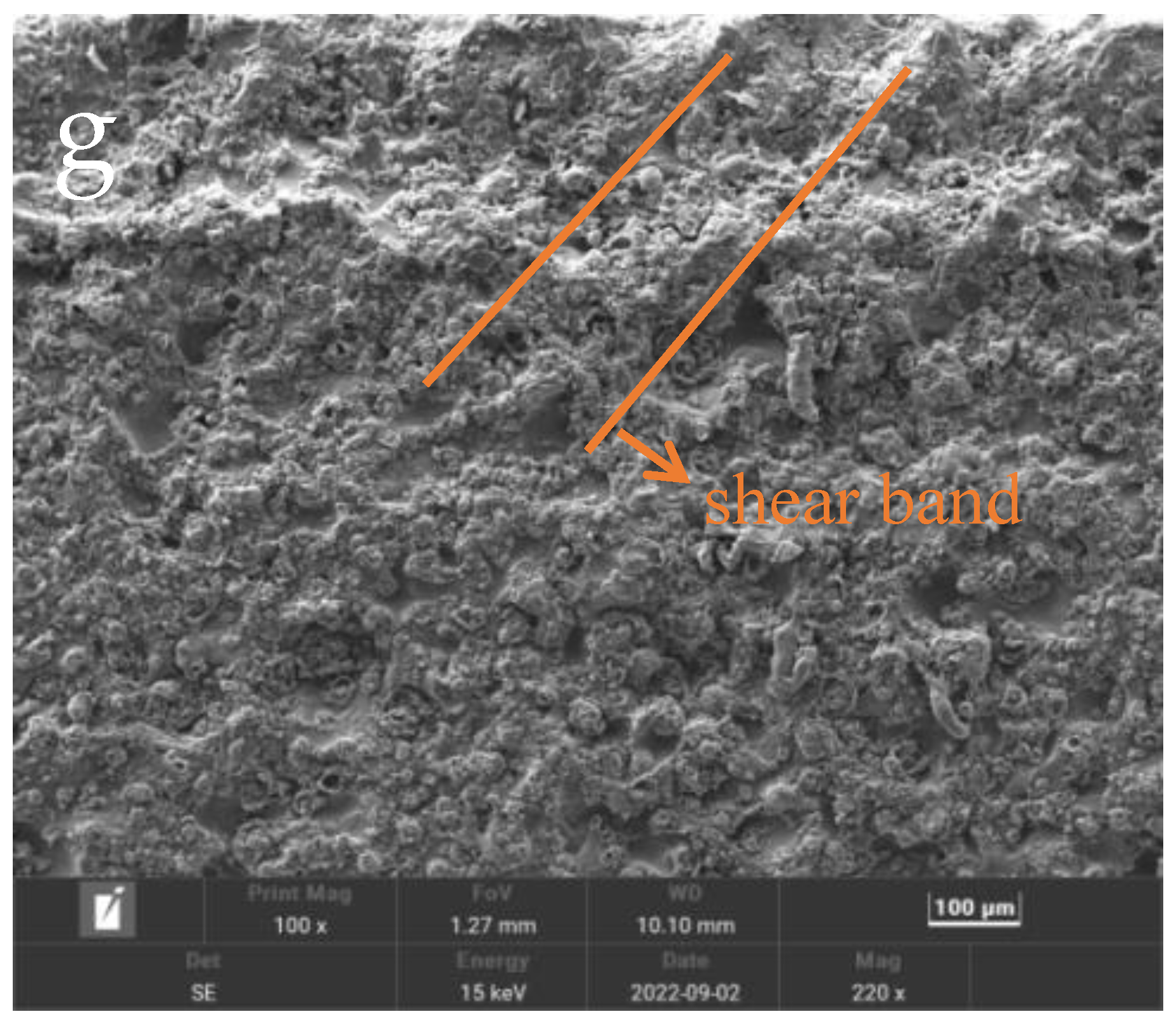
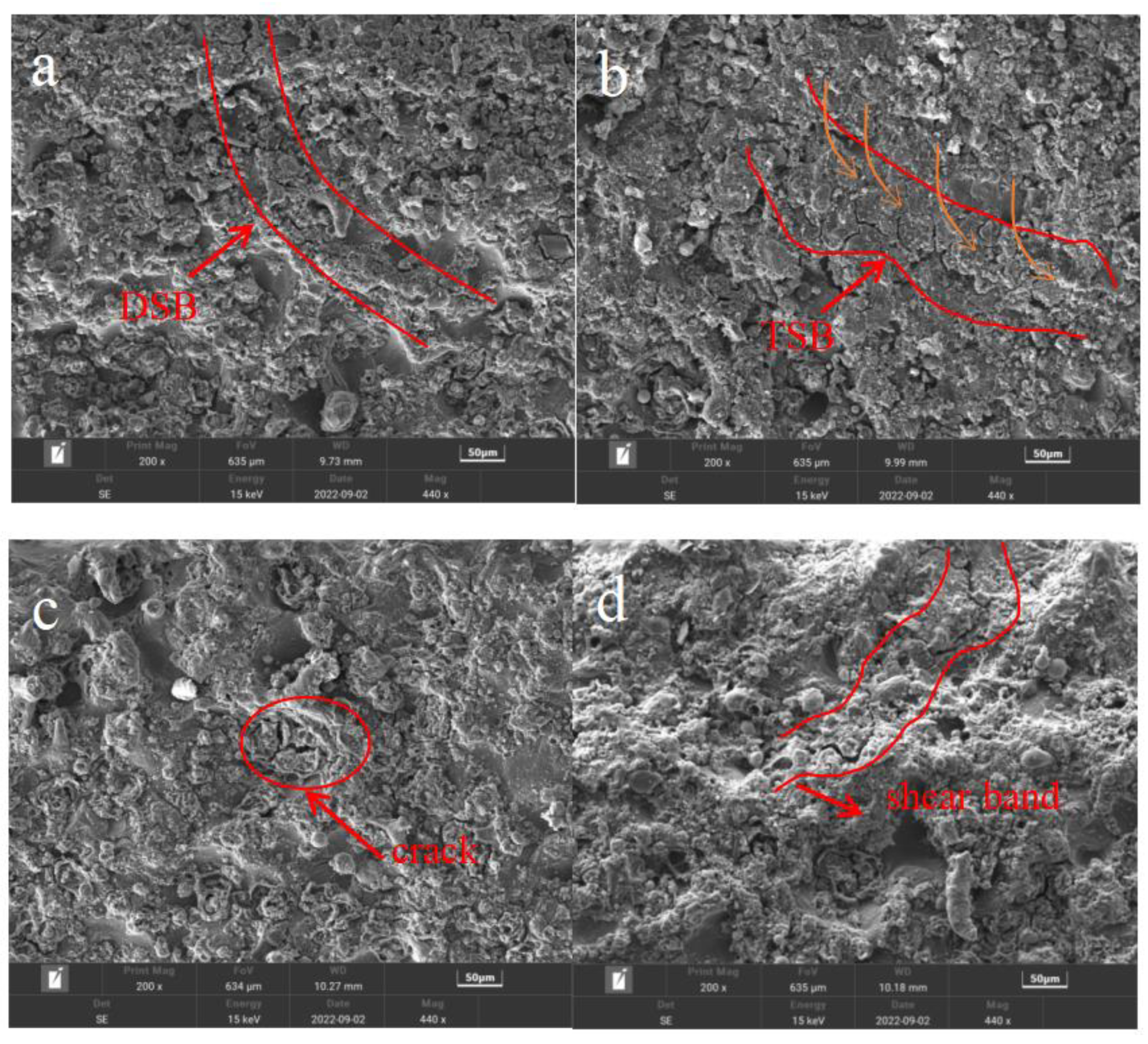
| Dynamic Impact | Quasi-Static Compression | |||||||
|---|---|---|---|---|---|---|---|---|
| Temperature/K | strain rate () | 1 × 10−1 S−1 | Sample 1 | |||||
| 1000 | 2000 | 3000 | 6000 | 7000 | 7500 | 8 × 10−2 S−1 | Sample 2 | |
| 298.15 | Sample 8 | Sample 16 | Sample 17 | 6 × 10−2 S−1 | Sample 3 | |||
| 323.15 | Sample 9 | Sample 10 | 5 × 10−2 S−1 | Sample 4 | ||||
| 373.15 | Sample 11 | Sample 12 | Sample 18 | Sample 19 | 3 × 10−2 S−1 | Sample 5 | ||
| 473.15 | Sample 13 | Sample 14 | Sample 15 | Sample 20 | Sample 21 | Sample 22 | 2 × 10−2 S−1 | Sample 6 |
| 6 × 10−3 S−1 | Sample 7 | |||||||
| Strain Rate (10−2 S−1) | |||||||
|---|---|---|---|---|---|---|---|
| 0.6 | 2 | 3 | 5 | 6 | 8 | 10 | |
| Yield strength (MPa) | 233.4 | 256.8 | 277.4 | 288.5 | 298.6 | 317.3 | 335.3 |
| A/MPa. | B/MPa | C | n | m |
|---|---|---|---|---|
| 233.4 | 404 | 0.43 | 0.74 | 1.83 |
| A/MPa. | B/MPa | |||||
|---|---|---|---|---|---|---|
| 233.4 | 404 | 0.81 | 0.74 | 1.83 | −0.03 | −3.1 |
| Strain rate (S−1) | 1000 | 2000 | 3000 | ||
| Absolute warming (ΔT)/K | 306.15 | 327.75 | 385.35 | 403.15 | 429.75 |
| Ambient temperature (T)/K | 473.15 | 473.15 | 323.15 | 373.15 | 473.25 |
| Theoretical temperature (ΔT+T)/K | 779.3 | 800.9 | 708.5 | 776.3 | 909.2 |
Publisher’s Note: MDPI stays neutral with regard to jurisdictional claims in published maps and institutional affiliations. |
© 2022 by the authors. Licensee MDPI, Basel, Switzerland. This article is an open access article distributed under the terms and conditions of the Creative Commons Attribution (CC BY) license (https://creativecommons.org/licenses/by/4.0/).
Share and Cite
Zhang, Q.; Huang, X.; Guo, R.; Chen, D. Study on Dynamic Impact Response and Optimal Constitutive Model of Al-Mg-Si Aluminum Alloy. Materials 2022, 15, 7618. https://doi.org/10.3390/ma15217618
Zhang Q, Huang X, Guo R, Chen D. Study on Dynamic Impact Response and Optimal Constitutive Model of Al-Mg-Si Aluminum Alloy. Materials. 2022; 15(21):7618. https://doi.org/10.3390/ma15217618
Chicago/Turabian StyleZhang, Qinmin, Xiaomin Huang, Ran Guo, and Dongyu Chen. 2022. "Study on Dynamic Impact Response and Optimal Constitutive Model of Al-Mg-Si Aluminum Alloy" Materials 15, no. 21: 7618. https://doi.org/10.3390/ma15217618
APA StyleZhang, Q., Huang, X., Guo, R., & Chen, D. (2022). Study on Dynamic Impact Response and Optimal Constitutive Model of Al-Mg-Si Aluminum Alloy. Materials, 15(21), 7618. https://doi.org/10.3390/ma15217618






